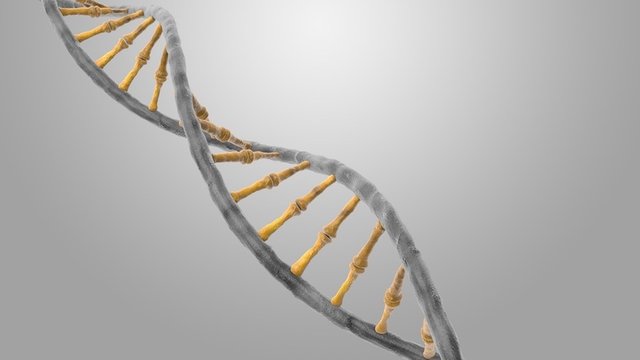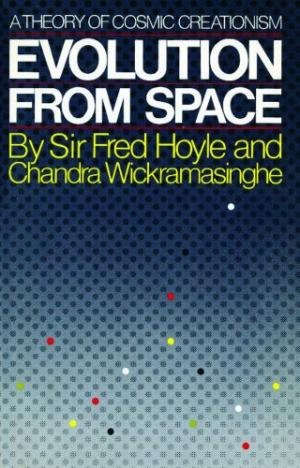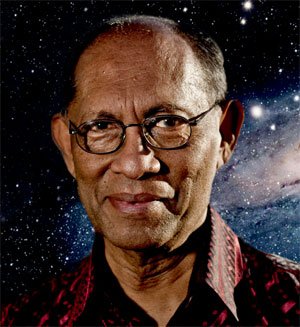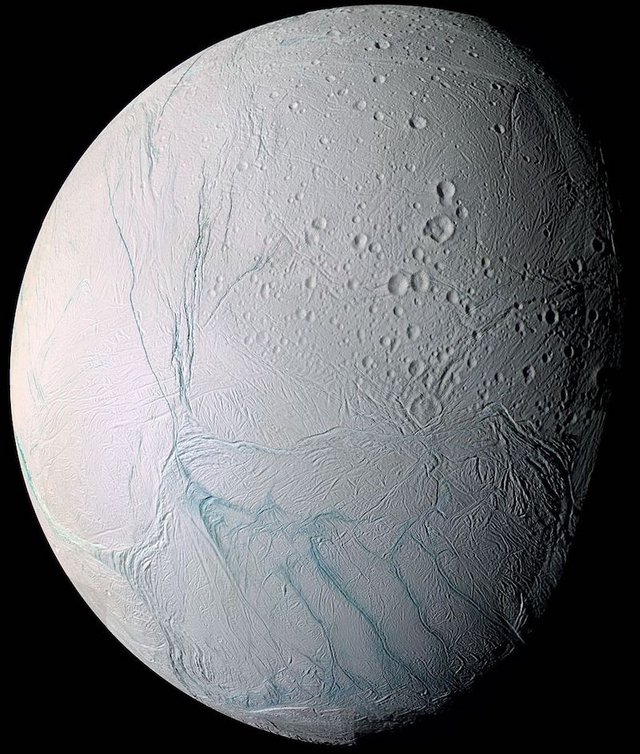FACT CANNON #5: The Origin of Life on Earth – Panspermia and Cosmic Ancestry
Or: Why You Must Read ‘Evolution From Space’ by Sir Fred Hoyle and Chandra Wickramasinghe
It’s funny how ideas spread themselves around, sometimes without any obvious means of transmission. A couple of months ago I started writing a piece for SteemIt to explain an idea that I’ve been nurturing which came to me a number of years ago. It was on the origin of life on Earth through panspermia, and was going to be my 'big reveal' to humanity. In researching that article though, I found out that someone else had already explored the idea much more rigorously and in greater depth than I would ever be capable of. In fact, the people involved were eminent scientists who published widely on it from the 1980's onwards, and I’ve subsequently read one of their books and found it to be absolutely amazing. On this basis I’ve decided to tell you about their book, ‘Evolution From Space’ and post my own ideas separately.
The Book
‘Evolution From Space’ was written by Sir Fred Hoyle and Chandra Wickramasinghe, and published in 1981. I‘ll give some background on the authors later on, but want to talk about the book first.
‘Evolution From Space’ is a fascinating, enjoyable and very readable book, and I strongly recommend a purchase and thorough read. In fact, as one of the founding texts of astrobiology, it should really be essential reading for anyone with even a passing interest in evolution, not to mention astrobiology itself. All of this makes it startling to me that the mechanism of cometary panspermia it presents is not widely known, even though the book was bublished 35 years ago.
Panspermia, the origin of life in space, is not a new idea. It seems that it was first proposed by the philosopher Anaxagoras in Ancient Greece, and the ideas were further investigated and broadened by 19th century scientists, including Nobel Prize winner Svante Arrhenius. What Hoyle and Wickramasinghe present here though are the scientific clues pointing to the reality of panspermia, along with a very well-developed proposal of how it could actually function, and a projection of what this might mean for the origin of life in the universe.
I will do my best to present a precis here:
The pointers to panspermia
- Certain terrestrial organisms have capabilities, and / or unexpressed genes for proteins, that cannot be explained by evolution by natural selection alone. For example, beans possess genes with the capacity to produce hemoglobin, and many types of extremophile bacteria can survive in conditions that do not and have never existed on Earth.
- Biological material has been found in the stratosphere at altitudes which rule out material from the surface of the planet.
- Life started on Earth almost instantaneously (in geological terms) after the planet became a viable environment, giving very little time for the origin of the process.
- Enzymes are far too complex to have arisen by the random association of amino acids, and by extension the chance origination of DNA is implausible. Fred Hoyle has been quoted as saying that the probability of the chance origination of enzymes in this way is equivalent to “the chance that a tornado sweeping through a junkyard might assemble a Boeing 747”. Even if abiogenesis (the emergence of life from non-living material) has happened like this at some location in the universe, the chance that this happened within the infinitesimal confines of a primordial soup on Earth is a statistical impossibility. To believe that abiogenesis occurred on Earth in this way in the face of staggering mathematical odds requires a huge leap of faith, and is geocentric in a similar way to the pre-Copernican belief that the sun and stars orbit the Earth.
The Hypothesis of Cosmic Ancestry
In view of the above, in all probability life originated elsewhere in the universe, and arrived on Earth by some other means.
The Mechanism of Cometary Panspermia
- Research by the pair suggests that interstellar dust is largely comprised of bacterial spores in varying stages of ‘suspended animation’ and/or decomposition. These bacteria act as vessels for DNA and other genetic material. Extremophile bacteria can survive for geological time periods in spore form in deep space.
- When interstellar gas condenses and a star forms, the star is initially super-heated. While this is the case conditions are right for bacteria to reproduce rapidly in a reservoir in the outer reaches of the star system, and this is one of the locations where natural selection has armored them with their extremophile survival capabilities.
- As the system cools, the bacteria become frozen into comets within the system’s Oort Cloud, with the comets acting as ‘deep freezers’ for the bacterial genetic material.
- Over the course of time, these comets can be gravitationally disturbed, with some heading inwards towards the star to pelt the inner solar system. They shed material as they near the star, which can then survive re-entry into a planetary atmosphere, and provide a means to seed the planet with pre-existing DNA contained within bacteria, viruses and other genetic material.
- This arrival of living cells on the planets from space is a continuos and ongoing process.
- Natural selection does indeed take place on the planetary bodies, but has the benefit of acceleration by selecting from pre-existing genetic ‘templates’ arriving from space, which are transferred between higher organisms via retroviruses. Organisms on the new planet utilize these ‘template’ genes via natural selection, (when they are suitable for the organism’s environmental niche), and the genes are then further refined by ongoing natural selection in the planetary environment.
- The newly enhanced genetic material of these new organisms is then returned to space by one of two means: A meteor impact, volcanic eruption or other traumatic event ejects material into space, which then moves between planets on rocks or by microscopic material being blown by stellar light pressure; or ultimately by the eventual expansion and supernova of the star.
- Either way the new DNA, complete with new and freshly refined genes, finds its way back to the interstellar dust inside bacterial spores and viruses, ready to be gravitationally drawn into new planetary accretion disks for the cycle to repeat in the creation of new star systems.
- In this way ‘ready-evolved’ genetic material is recycled billions of times between old and new star systems, giving evolution a far greater canvass than one confined solely to Earth, and meaning that the gene pool itself evolves on an interstellar basis.
Implications Of This Hypothesis
- On this basis Earth has probably been seeded with life on many separate occasions, giving many separate ‘beginnings’, some of which may not have taken hold.
- It helps to explain the apparent rapidity (in evolutionary terms) of some speciations. It also helps to explain 'evolutionary explosions’ and ‘radiations’, and especially convergent evolution such as the independent evolution of eyes, venom, flying etc in different species. In effect, the suggestion is that these events occur not only when a new environment becomes available to an organism, but also when a new swathe of appropriate genetic material arrives from space and is passed to an organism's genome via retrovirus.
- The hypothesis (in itself) does not address the central problem of abiogenesis.
- The authors argue that given the mechanism proposed, life would undoubtedly be ubiquitous in the universe, and on this basis it is not a stretch of the imagination to consider that other intelligences greater than our own are likely to exist. The mechanism proposed is also suggestive of Intelligent Design, and if we are to believe that this was the case, then it would follow that it would have been designed by a species that does not itself utilize the same biological system. Following this line of reasoning, due to the information / code based nature of DNA, and the fact that evolution on Earth has at this point led to a species devoted to the creation of new and ever more sophisticated machinery, they suggest that the mechanism may in fact have been designed by a machine intelligence as a means to distribute itself throughout the universe.
- As to the origin of the higher intelligence itself, the authors propose that it was likely created by a further higher intelligence, which in turn was created by higher intelligence, potentially ad infinitum. The authors suggest that the second higher intelligence may be capable of manipulating the fundamental constants of the universe, and on this basis it may simply be beyond our capability to understand the higher levels of intelligence, and therefore it is entirely plausible that the actual origin of life may be beyond our comprehension.
The Authors
I imagine that you’re thinking that this book originated in the world of pseudo-science, but this couldn’t be further from the truth, and the authors had very firm roots in the scientific establishment.
Sir Fred Hoyle
An English astronomer who originated the theory of nucleosynthesis in the 1940’s, predicting the 'Hoyle State' of carbon necessary for the creation of all lighter elements within stars. There is much debate as to why he did not receive the Nobel Prize for this ground breaking work, particularly given that one on his junior collaborators did in the 80’s. He also originally coined the phrase ‘Big Bang’ in 1949, was the founder and director of the Institute of Theoretical Astronomy at Cambridge University between 1967 and 1972, where for a while he tutored Stephen Hawking. Hoyle had a unique and very assertive personal style, which he used to great effect in the many books he wrote to popularize science and make it accessible to the masses. He also possessed a powerful imagination and insight, which led him to develop and champion many original ideas, although later in life his maverick style may have contributed to some rejection by the mainstream of the scientific community. He was hugely quotable, leaving behind many famous quotes (and mis-quotes) following his death in 2001.
Chandra Wickramasinghe
A Sri Lankan-born mathematician, astronomer and astrobiologist. He has resided in Britain for many years, collaborated with Sir Fred Hoyle for 4 decades, and written more than 30 books on astrophysics and related topics. A fellow of Jesus College Cambridge for a decade, he became professor of applied mathematics and astronomy at University College Cardiff in 1973, holding this and an equivalent post at the University of Cardiff until his retirement in 2006. He was also instrumental in setting up the Cardiff Centre for Astrobiology, and was co-founder of the Institute for the Study of Panspermia and Astroeconomics set up in Japan in 2014, where he is currently Research Director. Wickramasinghe is currently also Director of the Buckingham Centre for Astrobiology.
Yes, Hoyle and Wickramasinghe are well qualified, heavy weight scientists, with serious scientific credentials. They both have solid roots in the scientific establishment (Fred Hoyle was even knighted for services to astronomy in 1972), and approached their subject with due skepticism, although the nature of their field of study itself seems to have led their research away from the scientific mainstream.
Sir Fred Hoyle and Wickramasinghe have written a number of books on panspermia, both together and separately.
The Controversy and More Recent Supporting Evidence
I am not a scientist, nor an expert in evolution (although I have read reasonably widely on it), but as far as I can see there is nothing in ‘Evolution From Space’ that contradicts the principles of natural selection. In fact, it really just seems to extend the idea, giving it a far greater stage to act upon. However, the book is not circumspect in its challenge to the widely accepted paradigm that life spontaneously originated in a primordial soup on Earth; and Hoyle may have upset the applecart with his refutation of terrestrial abiogenesis. On reflection, it's likely that he also overstepped the mark with his reflections on Intelligent Design. Regardless of how you may feel about the perspicacity of his predictions in this area it is important to note that they are not necessary for the acceptance of the central theory; so it seems a shame if they did indeed whip up a backlash from the establishment. Sadly, orthodox science is often reactionary and woefully unwilling to evaluate alternative theories, and regardless of what actually caused it, the resulting controversy seems to have resulted in the books’ rejection by the scientific mainstream, and much to our loss, the subsequent burial of the theory of cometary panspermia.
This said, in the 35 years since the book’s publication more and more evidence has come to light in support of the central hypothesis. For example, the following discoveries:
- An ever increasing array of extremophiles, some of which have been scientifically proven to survive and remain viable on the surface of the ISS, some during planetary re-entry, and some in other space environments.
- Biotic particles in the stratosphere, at such a height where they could not have originated on the ground
- Rosetta’s discovery of organics on comet 67P/Churyumov
- Fossilized cyanobacteria and other microbes in numerous meteorites discovered by Richard Hoover and others over the last 20 years.
- Hubble’s detection of organic chemicals on at least one exoplanet
- ALMA’s detection of huge quantities of organic compounds (methyl cyanide and hydrogen cyanide) which could be markers for bacterial activity in the protoplanetary disc surrounding star MWC480.
It pays to retain a skeptical outlook on any scientific paradigm shift; however,
while some of these discoveries are still in themselves controversial, it cannot be denied that the weight of supporting evidence appears to be building up. It may be that there is truth in the old saying that there is no smoke without fire.
Perhaps we will get a definitive answer in the next decade or so with the inevitable re-examination of Martian soil (as the findings of the Viking lander in the 70s are now believed to have been inconclusive), and the study of the composition of water jets from cryovolcanoes on Europa and Enceladus.
Personally, I hope that Hoyle and Wickramasinghe’s hypothesis of cometary panspermia is vindicated in the near future. They seem to have been subjected to an unwarranted backlash, when they really deserve a degree of veneration as founding fathers of astrobiology. Not only would it be gratifying to see their pioneering work properly celebrated in posterity, but of course, if cometary panspermia does prove to be a reality, then it must surely change our perspective as a species, as we will by necessity have to come to terms with the fact that we really are just a tiny part of a fully living universe.
Regardless of how the evidence pans out, I strongly encourage you to track down their books if you are at all interested in this and similar topics. As a footnote I notice that Chandra Wickramasinghe published a new book 'The Search For Our Cosmic Ancestry' in 2014, which, although I have not read it yet, looks like it updates the central hypothesis with new evidence.
Further Thoughts
As I said at the beginning, I have my own armchair musings on panspermia, but I’ve done my best not to mix them with Hoyle and Wickramasinghe’s erudite work in this post. If you are interested in my thoughts, (and I really hope you are!), I’m hoping to post them separately in the next day or two.
FACT CANNON: A not so regular magazine loaded with incendiary facts and opinions.
Inspiration:
‘Evolution From Space’ – Sir Fred Hoyle & Chandra Wickramasinghe
https://en.wikipedia.org/wiki/Fred_Hoyle
Sir Fred Hoyle Biography
https://en.wikipedia.org/wiki/Chandra_Wickramasinghe
Previous editions of FACT CANNON:
FACT CANNON #1: Romanesco Broccoli, A Reality-Bending Vegetable
FACT CANNON #2: How Frankenstein Was Born In The Fiery Heart of A Super Volcano
FACT CANNON #3: The Sad Tale of Paul The Psychic Octopus
FACT CANNON #4: Pholcus – The Other People Who Live In Your House
If you enjoyed this edition of FACT CANNON, please upvote, comment, share and follow me. If you do maybe I’ll write more. If you don’t you may never hear from me again!
while some of these discoveries are still in themselves controversial, it cannot be denied that the weight of supporting evidence appears to be building up. It may be that there is truth in the old saying that there is no smoke without fire.
https://en.wikipedia.org/wiki/Fred_Hoyle
Sir Fred Hoyle Biography
https://en.wikipedia.org/wiki/Chandra_Wickramasinghe
FACT CANNON #1: Romanesco Broccoli, A Reality-Bending Vegetable
FACT CANNON #2: How Frankenstein Was Born In The Fiery Heart of A Super Volcano
FACT CANNON #3: The Sad Tale of Paul The Psychic Octopus
FACT CANNON #4: Pholcus – The Other People Who Live In Your House





While interesting, some of their statements are no longer true. Enzymes seem to be fairly likely from an evolutionary sense, even Nucleic acids fold into catalytic shapes.
I also disagree with statements like "life started instantaneously after the earth became suitable" thats misleading, of course it did. The components could have been combining for millions of years correctly but with no success prior to environmental suitability to support life.
Evidence point number two is contradicted by mechanism point seven. If the mechanism involved a way to spread the new biological material off of earth then that same mechanism explains biological material in the stratosphere. It also indicates that bacterial presence there is consistent with no panspermia.
As scientists we all know of this theory, it hasn't been buried or lost, it's just not as likely as other explanations. However we really don't know yet one way or the other.
Good post.
Thanks for the comment, really good to know someone’s read the post!
In this post I’m really just trying to relay H&W’s arguments from the 1981 book, so it’s unsurprising if some of it is out of date. In fact since writing this article I’ve done a lot of independent research (on the net, but trying very hard to wade through all the crap!), and I’m also about half way through Wickramasinghe’s ‘The Search For Our Cosmic Ancestry’. There is now a great deal more evidence supporting the cometary panspermia theory, even if some of the material presented in this post may be out of date. The hypothesis itself has also evolved a little in light of new evidence as would be expected of any theory of it’s age.
I’ll try to address your points though:
Personally I’m in no position to argue one way or another the likelihood of the spontaneous (though evolutionary) generation of enzymes, although I’ve seen no evidence on the net (that I’ve understood!) that suggests that this is now thought to be more likely. I’d appreciate any relatively straightforward sources you could recommend to help my understanding here!
‘Life started instantaneously after the Earth became suitable’. You may be disagreeing with my phrasing rather than the book's explanation here. I think Hoyle’s fundamental point was that if abiogenesis is such a difficult and unlikely event, why would it have happened ‘as soon as’ a suitable environment existed? (And if this is the case wouldn’t it happen all over the universe anyway? This one is my point, not Hoyle’s).
Evidence point no 2 contradicted by mechanism point 7. Yes I can see that - although again, I suspect that this is more a fault on the part of my attempted explanation rather than the theory itself. CW does address this point in his latest book very thoroughly, but yes, I concede your point as I’ve written it. Although other types of evidence can be highly suggestive, the clincher for panspermia is always going to be the confirmed discovery of biological or genetic material either in a meteorite or on an extraterrestrial body (or perhaps something more perplexing to do with the nature of the genetic code itself… but that’s for another post).
I’d challenge your point on it being less likely than other explanations though. Which explanations? I assume you’re referring to terrestrial abiogenesis? If so I think we could be in a position to have unequivocally proved panspermia one way or another within the next 30 years or so, but I don’t think we can say the same for terrestrial abiogenesis (unless things have moved radically from my understanding?). My feeling though is that study of panspermia does not seem to attract the funding or attention that it should - it is certainly no longer a fringe topic.
Given your scientific background I’d strongly suggest a read of ‘The Search For Our Cosmic Ancestry’, as said earlier there’s been a huge amount of new evidence since 1981 which is set out in the book, and I think it will address some of your concerns better than I have here.
Once again, really do appreciate your response - haven’t posted for a while and I did wonder whether anyone was still reading or whether my main audience is Bots these days!
So I will respond to some of this:
A while back some experiments were done showing that precursor biomolecules were able to be spontaneously generated from an environment similar to one found in the early earth. So there is some president that spontaneous generation of the early building blocks of life are possible. These molecules do seem to want to spontaneously assemble. However the conditions in the early earth were not conducive to the formation of the more complex molecules (IE long RNA chains... etc.) but that doesn't mean that these sorts of molecules weren't self assembling and falling apart over and over again until one day when the environment became more suitable for their stability. At this point these sort of moleucles would have seemed to appear almost overnight, all at once. Conditions occurred that provided stability to processes that were already occurring but not able to fully form to complete and stable states. This plausibly justifies why life quickly happened as soon as a suitable environment existed.
I don't think that confirms much of anything. It seems to be fairly obvious that the molecules responsible for life here on earth are energetically favorable to form. It wouldn't surprise me if these sorts of molecules were able to form in other places in space as well. I am not saying I don't think panspermia happened, I am just saying I don't know that the observation you are looking for would conclusively prove it.
I wrote a short post about the "RNA World Hypothesis." About how life could have evolved out of early simple organisms that were actually just catalytic RNA molecules. This is another fun theory about how life may have begun, and their is some precident that an RNA world may not be entirely a throwaway concept (I mean consider that the complex responsible for protein synthesis, the Ribosome, is largely a catalytic RNA complex, with a bunch of structural proteins).
At the end of the day it is going to be interesting to see as more evidence comes in regarding the early stages of life on Earth. Perhaps we really were seeded by advanced alien life, or perhaps we were seeded by random chance, or perhaps life on earth is the first life in the universe, or perhaps there is life all over the place and it is independently existing due to the properties of the elements that result in the biomolecules that create life. I do not know the answer to any of this, however it is fun to think about.
Thanks for the response. I’ve read your article on RNA World - well written and very helpful, cheers!
From your response it seems to me that you favour the view that self starting evolution is a natural process, and therefore almost inevitable across the universe? I’m not sure of the actual probability of that vs panspermia distribution, but I wouldn’t necessarily argue with it. What I personally find extremely difficult to believe is that abiogenesis could have occurred solely on Earth. That takes a leap of faith almost as great as belief in a religious creation myth. So I think we are both coming from the angle that life is very very likely to be a widespread phenomenon across the universe? That for me is the exciting prospect behind this.
Of course, both RNA World and panspermia could be accurate, there is nothing mutually exclusive between the two, panspermia would just give the other process an early boost, and then contribute to a universal gene pool to accelerate things even further.
As you say, there are a range of possible explanations - and I’m also very much looking forward to see how evidence unfolds. I’m hopeful we’ll see at least a provisional answer within our life times.
We're I to subscribe to a theory I would subscribe to one where the building blocks for life were self assembling yes. I would also suspect that to happen everywhere the necessary elements were present, and by that logic would include large amounts of the known universe. But that is more of a belief then based in actual scientific reality. :)
This has been a nice conversation, thanks for taking the time to chat and share your views!
What a great write up. This is so exciting for me to come across such subject on Steemit.com and can't wait to read more as I am still, somehow, on an astrophysics stint! Namaste :)
Cheers! Very much appreciate your support!
My pleasure really! Namaste :)
This post has been linked to from another place on Steem.
Learn more about and upvote to support linkback bot v0.5. Flag this comment if you don't want the bot to continue posting linkbacks for your posts.
Built by @ontofractal